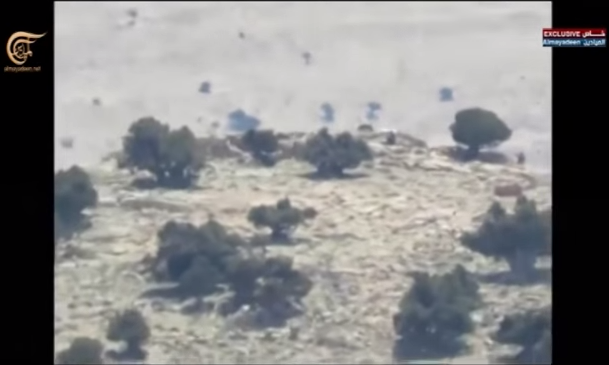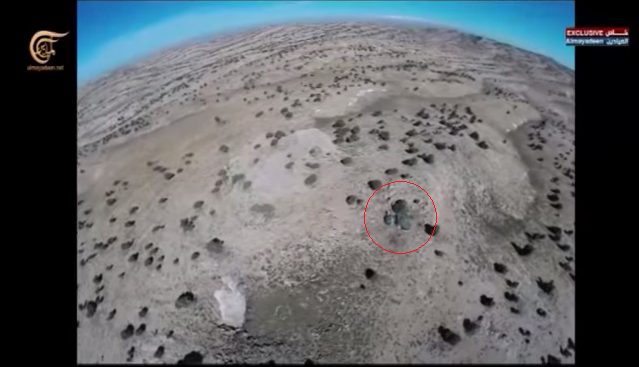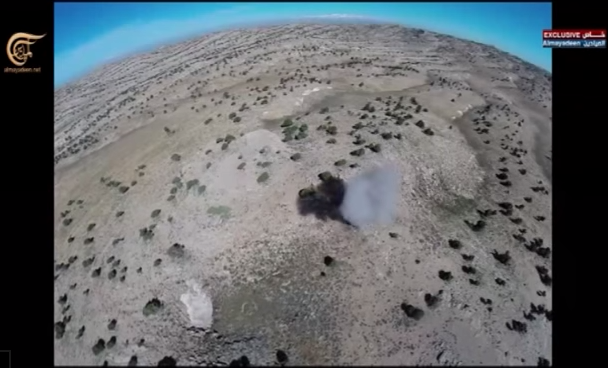Combat use of multicopter in Syria
Accidentally, the Lebanese Almayadin channel (Al Mayadeen) reported about the battles in the mountainous region of Kalamoun and the destruction of the militants' stronghold on one of the hills with the help of a guided missile. In the report there are video footage shot by a copter. I was interested in the role of the copter in this fight.
Actually, the report itself. And under the cut, my transcript of what I saw, which I wanted to share - the line between a toy and a weapon is too transparent:
Historical background of events:
Armed conflict continues in Syria, which began as a civil protest and artificially heated in 2011 into armed conflict. Syria has always had difficult relations with its neighbors for political and religious reasons. Armed conflict took advantage of the rich monarchies of the Persian Gulf. A stream of mercenaries, weapons, and Islamic radicals has poured into Syria. At the moment, the war in Syria has little relevance to the initial political reasons - this is a war of Sunnis and Shiites (Alawites), spreading beyond Syria. To varying degrees Lebanon, Iraq, Saudi Arabia, Jordan, Iran are participating in this war.
The Almayadin (Al Mayadeen) channel report on the battles in Kalyamun is not chronologically edited. Also, the shooting was done at different times - the weather changes, in the frame the use of military equipment, apparently the battle (siege of height) here lasted a long time. By the way, in other reports downloaded at the same time, there are more powerful guns on cars on the channel on Youtube.


I made the frames and put them in a logical order.
Militants at the top of the hill:



Rocket launch:


The frame allows you to see how far the target is:

The rocket flies to the place where the militants were visible:

I will repeat the frame above with the militants:

Explosion:

Copter video:

Explosion:

After a dozen seconds:

Further shooting of soldiers rising on a hill and shooting directly on the hill.
Destroyed fortified point. I suspect that scraps of rags are what's left of the action movie.

What happened now is clear. The role of the copter is also obvious - the adjustment of fire on the positions of the militants. The question remains, how the rocket flew right on target. In this matter, the moment before the launch helped. Although almost nothing is visible, the silhouette of a compact rocket launcher has awakened memories of the old UT magazine, where there was an article and illustrations of a compact anti-tank missile system.

Google to help and soon find the answer:

This is an anti-missile missile system of the “Baby” type .

Further, it is easier to search and a video on Youtube confirms that this is exactly the rocket and explains why it has such a strange trajectory curve.
Just think:
Kopter - the modern most difficult microprocessor device with a radio channel, with video cameras.
And the rocket, controlled by a three-core wire with a length of 3200 meters. Inside no electronics like 50 years ago.
Kopter - showed the operator where the fortified point of militants is located, and the missile was guided through an optical sight, watching the bright tracer of the missile.
Such an effective combination of technologies with a difference of 50 years really surprised me and inspired this article.
I hope the time to read the article was not wasted. Technology goes to the masses. And the world is not becoming safer.
Around 2005, not far from these places, the same combination of modern and old technologies happened. Specifically, the appearance of Google Earth in 2005 allowed the militants to easily and accurately measure the distance from the intended launch site of improvised primitive rockets to targets in Israel and to increase accuracy.

Actually, the report itself. And under the cut, my transcript of what I saw, which I wanted to share - the line between a toy and a weapon is too transparent:
Historical background of events:
Armed conflict continues in Syria, which began as a civil protest and artificially heated in 2011 into armed conflict. Syria has always had difficult relations with its neighbors for political and religious reasons. Armed conflict took advantage of the rich monarchies of the Persian Gulf. A stream of mercenaries, weapons, and Islamic radicals has poured into Syria. At the moment, the war in Syria has little relevance to the initial political reasons - this is a war of Sunnis and Shiites (Alawites), spreading beyond Syria. To varying degrees Lebanon, Iraq, Saudi Arabia, Jordan, Iran are participating in this war.
The place of the battle and the warring parties
This story was filmed by the Lebanese television channel Almajadin , which the Western media associate with Iran, which the television channel itself rejects.
On May 12, 2015, Hezbollah and the Syrian Arab Army occupied two strategically important hills in the mountainous region of Kalamoun (Kalyamune), located west of Damascus, on the border between Lebanon and Syria.
')

The gorge (valley) of Kalamun, which is of strategic importance can be compared with the Panjshir Gorge in Afghanistan. Kalamun, the center of which is the city of Yabrud, stretches for several tens of kilometers along the main road Damascus - Aleppo towards the Lebanese border. Control of this strategic area means control of the eastern Lebanese border, through which the vital weapons routes and the transfer of gangs pass through for the militants. Without control of Kalamun, the successful actions of the Islamists in Damascus will not be possible. Control of Calamoun would allow militants to cut off Damascus from communication with Homs and try to surround Damascus from the north-west and from the west. But the militants never fully captured Kalamoun.
Since September 2012, the militants have twice organized “battles” for Kalamun, but each time failed. At the end of 2013, for the next attempt to capture the gorge, militants gathered large forces of up to 20 thousand people
Understanding the strategic importance of the gorge, the Syrian Arab Army planned and launched an offensive called the “White Mountains”, which began in early 2014. In difficult mountain conditions, the Army avoided direct battles in villages in the gorge, and consistently, one by one, occupied the dominant heights.
By the end of March, the city of Yabrud was liberated and the militant group was almost completely destroyed, part of which fled to Lebanon. Then the Syrian army began clearing the gorge in its entirety from small groups, penetrating from the territory of Lebanon. In turn, Syrian militants, including the jihadists of the Islamic State group and the Islamists of the rival Al-Nusra Front, also penetrated into Lebanese territory.
Neither Syria nor Lebanon can control the extended border in remote mountainous areas, as the militants use to create transshipment bases. Since May 5, the offensive of the Syrian Army and Hezbollah began. In 5 days, we managed to clear 50 kilometers on both sides of the border and free the border checkpoint.
Particularly fierce battles with Syrian Islamist militants were fought over two heights, from where a part of the Lebanese border and the Syrian city Yabrud located nearby were shot. The seizure of two hills is also important for Lebanon: recently, Syrian Islamists periodically fired rockets at the Lebanese Bekaa Valley.
Since August of last year, Islamists began to actively attack Lebanese settlements and army roadblocks after the Syrian army began to push Islamist troops back to the border in Kalamoun, and the Lebanese Shiite militaries and fighters do not allow them to go deep into Lebanon.
Syrian Islamists meanwhile claim that they are attacking the Lebanese Bekaa Valley solely because the Lebanese Shiite organization Hezbollah invaded Syria and its militants are fighting on the side of President Bashar Al-Assad.
On May 12, 2015, Hezbollah and the Syrian Arab Army occupied two strategically important hills in the mountainous region of Kalamoun (Kalyamune), located west of Damascus, on the border between Lebanon and Syria.
')

The gorge (valley) of Kalamun, which is of strategic importance can be compared with the Panjshir Gorge in Afghanistan. Kalamun, the center of which is the city of Yabrud, stretches for several tens of kilometers along the main road Damascus - Aleppo towards the Lebanese border. Control of this strategic area means control of the eastern Lebanese border, through which the vital weapons routes and the transfer of gangs pass through for the militants. Without control of Kalamun, the successful actions of the Islamists in Damascus will not be possible. Control of Calamoun would allow militants to cut off Damascus from communication with Homs and try to surround Damascus from the north-west and from the west. But the militants never fully captured Kalamoun.
Since September 2012, the militants have twice organized “battles” for Kalamun, but each time failed. At the end of 2013, for the next attempt to capture the gorge, militants gathered large forces of up to 20 thousand people
Understanding the strategic importance of the gorge, the Syrian Arab Army planned and launched an offensive called the “White Mountains”, which began in early 2014. In difficult mountain conditions, the Army avoided direct battles in villages in the gorge, and consistently, one by one, occupied the dominant heights.
By the end of March, the city of Yabrud was liberated and the militant group was almost completely destroyed, part of which fled to Lebanon. Then the Syrian army began clearing the gorge in its entirety from small groups, penetrating from the territory of Lebanon. In turn, Syrian militants, including the jihadists of the Islamic State group and the Islamists of the rival Al-Nusra Front, also penetrated into Lebanese territory.
Neither Syria nor Lebanon can control the extended border in remote mountainous areas, as the militants use to create transshipment bases. Since May 5, the offensive of the Syrian Army and Hezbollah began. In 5 days, we managed to clear 50 kilometers on both sides of the border and free the border checkpoint.
Particularly fierce battles with Syrian Islamist militants were fought over two heights, from where a part of the Lebanese border and the Syrian city Yabrud located nearby were shot. The seizure of two hills is also important for Lebanon: recently, Syrian Islamists periodically fired rockets at the Lebanese Bekaa Valley.
Since August of last year, Islamists began to actively attack Lebanese settlements and army roadblocks after the Syrian army began to push Islamist troops back to the border in Kalamoun, and the Lebanese Shiite militaries and fighters do not allow them to go deep into Lebanon.
Syrian Islamists meanwhile claim that they are attacking the Lebanese Bekaa Valley solely because the Lebanese Shiite organization Hezbollah invaded Syria and its militants are fighting on the side of President Bashar Al-Assad.
The Almayadin (Al Mayadeen) channel report on the battles in Kalyamun is not chronologically edited. Also, the shooting was done at different times - the weather changes, in the frame the use of military equipment, apparently the battle (siege of height) here lasted a long time. By the way, in other reports downloaded at the same time, there are more powerful guns on cars on the channel on Youtube.


I made the frames and put them in a logical order.
Militants at the top of the hill:



Rocket launch:


The frame allows you to see how far the target is:

The rocket flies to the place where the militants were visible:

I will repeat the frame above with the militants:

Explosion:

Copter video:

Explosion:

After a dozen seconds:

Further shooting of soldiers rising on a hill and shooting directly on the hill.
Destroyed fortified point. I suspect that scraps of rags are what's left of the action movie.

What happened now is clear. The role of the copter is also obvious - the adjustment of fire on the positions of the militants. The question remains, how the rocket flew right on target. In this matter, the moment before the launch helped. Although almost nothing is visible, the silhouette of a compact rocket launcher has awakened memories of the old UT magazine, where there was an article and illustrations of a compact anti-tank missile system.

Google to help and soon find the answer:

This is an anti-missile missile system of the “Baby” type .

In the USSR, complexes such as “Baby” were produced until 1984. Under the license, they were produced in Bulgaria, Iran, Yugoslavia and China. In total, the “Baby” complex was in service with more than forty-five countries of the world.
Complex "Baby" a lot and very successfully fought. The most effective was the first mass use of the “Baby” type complexes during the “ Doomsday War ” in the Middle East. In the early days of the Arab-Israeli war of 1973, the Egyptian infantry with the help of the “Baby” complex inflicted a crushing defeat on Israeli tank units. According to the Arab side, these complexes destroyed about 800 Israeli tanks. Only on October 6, 1973, for example, was the 252nd Panzer Division of Israel completely defeated — over a hundred vehicles were hit.
For service "Baby" needed an experienced operator. In combat, the operator monitors the flight of the rocket and corrects it . If the distance to the target is less than 1000 m, it directs the “Baby” “by eye”. At long distances, it uses an 8x zoom scope. This contributes to a well-distinguished tracer on the tail of the rocket.
The projectile is controlled and guided to the target by commands transmitted to the projectile by wire from the control panel , while observing the projectile and aiming at the optical viewfinder.
Further, it is easier to search and a video on Youtube confirms that this is exactly the rocket and explains why it has such a strange trajectory curve.
Just think:
Kopter - the modern most difficult microprocessor device with a radio channel, with video cameras.
And the rocket, controlled by a three-core wire with a length of 3200 meters. Inside no electronics like 50 years ago.
Kopter - showed the operator where the fortified point of militants is located, and the missile was guided through an optical sight, watching the bright tracer of the missile.
Such an effective combination of technologies with a difference of 50 years really surprised me and inspired this article.
I hope the time to read the article was not wasted. Technology goes to the masses. And the world is not becoming safer.
Around 2005, not far from these places, the same combination of modern and old technologies happened. Specifically, the appearance of Google Earth in 2005 allowed the militants to easily and accurately measure the distance from the intended launch site of improvised primitive rockets to targets in Israel and to increase accuracy.

Source: https://habr.com/ru/post/367057/
All Articles